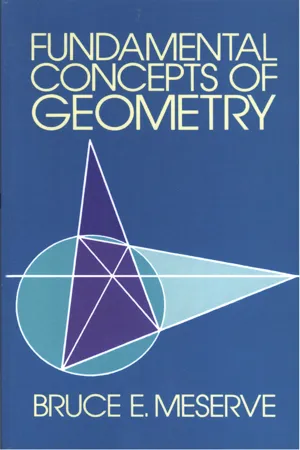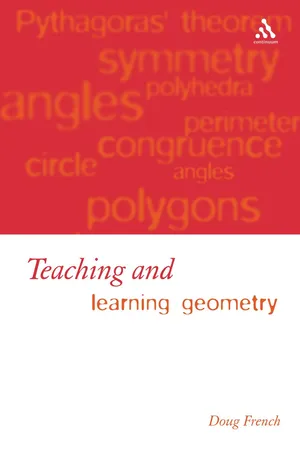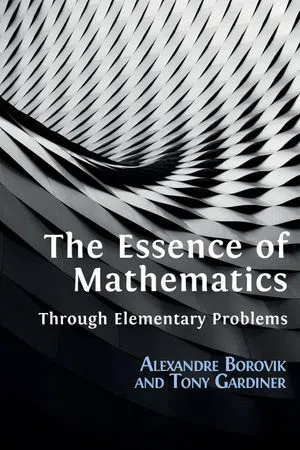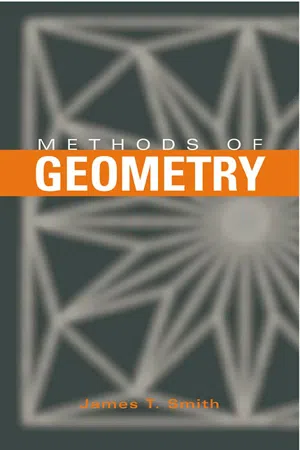Mathematics
Fundamentals of Geometry
The fundamentals of geometry encompass the basic principles and concepts that form the foundation of the study of shapes, sizes, and properties of space. This includes understanding points, lines, angles, and shapes, as well as concepts such as congruence, similarity, and symmetry. Geometry also involves the study of spatial relationships and the application of geometric principles to solve real-world problems.
Written by Perlego with AI-assistance
Related key terms
1 of 5
4 Key excerpts on "Fundamentals of Geometry"
- eBook - ePub
- Bruce E. Meserve(Author)
- 2014(Publication Date)
- Dover Publications(Publisher)
CHAPTER 1 FOUNDATIONS OF GEOMETRY The word “geometry” is derived from the Greek words for “earth measure.” Since the earth was assumed to be flat, early geometers considered measurements of line segments, angles, and other figures on a plane. Gradually, the meaning of “geometry” was extended to include the study of lines and planes in the ordinary space of solids, and the study of spaces based upon systems of coordinates, as in analytic plane geometry, where points are represented by sets of numbers (coordinates) and lines by sets of points whose coordinates satisfy linear equations. During the last century, geometry has been still further extended to include the study of abstract spaces in which points, lines, and planes may be represented in many ways. We shall be primarily concerned with the fundamental concepts of the ordinary high-school geometry — euclidean plane geometry. Our discussion of these concepts is divided into three parts: the study of the foundations of mathematics (Chapter 1), the development of euclidean plane geometry from the assumption of a few fundamental properties of points and lines (Chapters 2 through 6), and a comparison of euclidean plane geometry with some other plane geometries (Chapters 7 through 9). The treatment of the second part —the development of euclidean plane geometry — forms the core of this text and emphasizes the significance of the assumptions underlying euclidean geometry. Together, the three parts of our study enable us to develop an understanding of and appreciation for many fundamental concepts of geometry. 1–1 Logical systems. We shall consider geometries as logical systems. That is, we shall start with certain elements (points, lines,. . .) and relations (two points determine a line,. . .) and try to deduce the properties of the geometry - eBook - PDF
- Doug French(Author)
- 2004(Publication Date)
- Continuum(Publisher)
Chapter 1 The Role of Geometry WHY LEARN GEOMETRY? Geometry has an immediate intuitive appeal at a simple level. From an early age children play with shapes, noting their obvious properties and seeing how they relate to each other. They also observe a wide variety of both simple and sophisticated geometrical configurations in their surroundings and acquire some of the language associated with them. They learn informally to recognize shapes such as circles, squares and triangles and they begin to understand words like horizontal, vertical and parallel. The first steps in the study of geometry are concerned with naming, describing, classifying and making links to measurement, position and movement. Describing and classifying are not necessarily trivial tasks, as becomes very evident when, for example, we look at the properties of all the different quadrilaterals and the links between them. Moreover they lead on to the more demanding requirements of defining and deducing. Measurement is clearly of immense practical importance and establishes students' under-standing of the ideas of length and angle and associated ideas like area and volume, but the essence of geometry and the source of its endless fascination is the way in which deduction plays a central role in proving results that are often both simple and surprising. An excellent classroom example which encapsulates this element of surprise is illustrated in Figure 1.1. Students are asked to draw any quadrilateral, to mark the midpoints of the edges and then to join those four points to form another quadrilateral. Comparing the many examples that are produced suggests that the result is always a parallelogram. This can be demonstrated very dramatically by constructing the configuration on a computer screen using dynamic geometry software and observing what happens as the shape of the quadrilateral is changed as its vertices are dragged to different positions. - Tony Gardiner, Alexandre Borovik(Authors)
- 2019(Publication Date)
- Open Book Publishers(Publisher)
However, these subtle formalisms are totally irrelevant for beginners, who need an approach • based on concepts which are relatively familiar ( points, lines, triangles etc.), and • whose basic properties can be formulated relatively simply. The subtlety and flexibility of dynamic geometry software may be hugely impressive; but if students are to harness this power, they need prior mastery of some simple, semi-formal framework, together with the associated language and modes of reasoning. Despite the lack of an accepted consensus, the experience of the last 50 years would seem to suggest that the most relevant framework for beginners at secondary level involves some combination of: • static , relatively traditional Euclidean geometry, and • Cartesian, or coordinate (analytic) geometry. 5.2. Euclidean geometry: a brief summary Philosophy is written in this grand book – I mean the universe – which stands continually open to our gaze, but it cannot be understood unless one first learns to comprehend the language and to interpret the characters in which it is written. It is written in the language of mathematics, and its characters are triangles, circles, and other geometrical figures, without which it is humanly impossible to understand a single word of it; 174 Geometry without these, one is wandering about in a dark labyrinth. Galileo Galilei (1564–1642) This section provides a detailed, but compressed, outline of an initial formalisation of school geometry – of a kind that one would like good students and all teachers to appreciate. It is unashamedly a semi -formal approach for beginners, not a strictly formal treatment (such as that provided by David Hilbert (1862–1943) in his 1899 book Foundations of Geometry , or in the more detailed exposition by Edwin Moise (1918–1998) Elementary Geometry from an Advanced Standpoint , published in 1963).- eBook - PDF
- James T. Smith(Author)
- 2011(Publication Date)
- Wiley-Interscience(Publisher)
It was published as an appendix to a controversial and widely circulated philosophical treatise that analyzed the basis of all understanding: Discours de la mithode pour bien conduire sa raison, et chercher la verite dans les sciences. Descartes' work was translated, clarified, and publicized during the middle 1600s. With that of many other mathematicians who were concerned with the same problems at the same time, it laid the foundation for the application of algebra—and later, calculus—to geometry and science. By the time of Newton's work in the late 1600s, mathematical mainstreams had formed, algebra had become routine, and coordinate geometry had reached the form we know today. 2.6 Foundation problem Concepts Are the Euclidean and coordinate models equivalent? What are numbers? Is every number the length of some segment? Defining the real number system Rephrasing and augmenting Euclid's axioms As mentioned in section 2.4, Euclid didn't use numbers per se as lengths of line segments. He calculated with segments directly using integer arith- metic, and handled incommensurable segments with approximation tech- niques. But coordinate geometry was based on the number system as it had evolved by Descartes' time. Euclidean geometry and coordinate geometry provide quite different but complementary models of the same subject. We know from experience that some theorems are easier to derive in Euclid's system, others with coordinate methods. Are there any that can be derived in one but not the other? This is the foundation problem: whether the two models are equivalent. That is, do they have the same theorems? 36 FOUNDATIONS It's easy to see that Euclid's axioms are true if you interpret points as triples of coordinates and lines as point sets defined by linear equations. It follows that the theorems of Euclidean geometry are all true statements in coordinate geometry.
Index pages curate the most relevant extracts from our library of academic textbooks. They’ve been created using an in-house natural language model (NLM), each adding context and meaning to key research topics.



